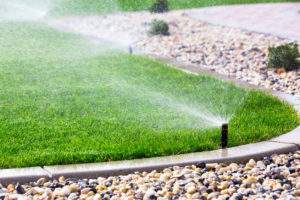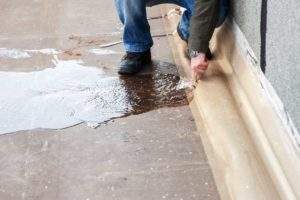Protecting your Sprinklers during Winter
Preparing your home for winter is an essential step to take annually in order to avoid costly repairs, and it’s important not to forget the things that need winterized beyond the walls of your home. Sprinkler winterization is key to making sure you don’t end up with a soggy mess come springtime.
How do I winterize my sprinkler system?

- Insulate
- To begin, shut off the water supply to your sprinkler system. Then, insulate the main shut-off valve for the system (you can simply wrap it in insulation). Also, insulate any above-ground pipes. Even though there shouldn’t be any water running through them, insulating adds another layer of protection.
- Turn off automatic systems
- Your sprinkler system is probably on a timer, so you’ll want to disable that for the winter. Most systems have a “rain mode,” which won’t fully reset all of your settings, so that is generally a better choice than fully shutting the system down.
- Drain connected pipes
- There are three ways to drain your pipes as you prep for winter. These processes can be fairly complicated, and for the sake of safety, we recommend that you contact a specialist in order to do them properly while staying safe.
- The pipes can be drained using the manual drain valve, the automatic drain valve, or the compressed air blow-out method.
- It is particularly important to drain the water to prevent blowing out the sprinkler system in areas with colder climates, as when the ground freezes, so does any water left in underground pipes. Sprinkler winterization is important in all climates that experience any below-freezing weather, though, even if you don’t drain 100% of the water from your outdoor pipes.
- Protect Irrigation System Valves and Backflow Preventers
- Don’t forget to winterize any above-ground backflow preventers and valves while you’re at it. Your owner’s guide for your sprinkler or irrigation system should have detailed instructions to help you locate these, and prepare them for winter.
How do I drain my sprinkler system?
If it’s financially feasible for you, it is always best to hire a professional to blow out your sprinkler or irrigation system, but at the very least, you should drain the water before winter comes.
Warning: If you decide to blow out the system on your own, be careful! Remember that most air compressors go up to 120 psi, but 50-60 psi is generally recommended for blowing out the sprinkler system, and pressure above 40 psi can cause damage to your system if done incorrectly. Also, safety first! If you blow out your own sprinkler system, wear goggles and never stand directly over irrigation pipes, sprinklers, or valves while the air compressor is running.
What you can safely do on your own, however, is drain your valves. Here are the steps you will need to take to either manually or automatically drain your valves:
How do I drain my sprinkler system if I have a manual drain valve?
- Locate the manual drain valves downstream of each zone valve. These are situated at the lowest points in the sprinkler system, where water collects when the system is off.
- Turn off the water supply by closing the main valve to the sprinkler system.
- These valves are often located on a separate branch near the water meter. Look for a “T” connection.
Open all of the manual drain valves for each zone in the sprinkler or irrigation system, and leave them open so that all the water drains from the pipes and sprinkler heads. Leave these drain valves open for a few days. - Open the drain valves located upstream of each zone valve to dump water from the main line.
- Drain all sprinkler heads by lifting them up and manually draining any water left inside.
- Close all drain valves.
How do I drain my sprinkler system if I have an automatic drain valve?
- Turn off the water supply by closing the sprinkler system’s main valve. As pressure inside the system falls, the water will drain automatically.
- Open the drain cap, located between the main valve and the backflow device. This will remove any water trapped in this section of the pipe.
- Drain all sprinkler heads by lifting them up and manually draining any water left inside.
Remember that if you want absolutely all of the water out of your sprinkler system, hiring a professional is your best bet, as they can safely and correctly perform a sprinkler system blowout.
What if I don’t drain my sprinkler system?

You may end up with flooding in your crawl space, window wells, and basement if you’re not careful, as well as areas of soggy ground. All of this is a recipe for mold growth, which can be a serious problem.
If you find yourself needing water removal or mold remediation, Abbotts would be happy to help, and is available 24/7. Remember that the faster you address water damage, the less likely you are to have a mold situation on your hands, so give us a call if you need water damage addressed quickly.

